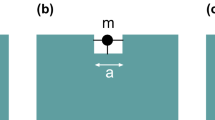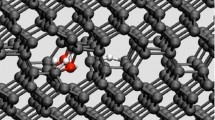Abstract
We are grateful to Dr. B.N.J. Persson for his prompt attention to our work (Hu et al. in Tribol Lett, https://doi.org/10.1007/s11249-019-1247-7, 2020). In his Comment, he remarks (i) that near-critical damping of motion in/on solids, one of our main results, is well known for atoms and molecules at surfaces and (ii) that this result may be invalid for real practical cases (Persson in Tribol Lett, this issue). We fully agree with both statements. However, some discussion is justified.
Similar content being viewed by others
Avoid common mistakes on your manuscript.
In [1] we analyzed the vibrational motion that directly follows at the surface of a crystalline solid after an atomic-scale slip event. In this theoretical analysis, we considered a completely harmonic solid and on purpose left out damping. In spite of this lack of ‘deliberate’ damping, we obtained slip-induced motion with surprisingly strong damping characteristics. We showed that the rapid reduction in the atomic displacement amplitudes and velocities is a multi-phonon effect; it reflects the combined evolution of a large number of vibrational eigenmodes that are simultaneously excited in the slip event. The phonons in this wave packet all start in phase, but the differences in their vibration frequencies make them run out of sync with each other on a timescale comparable to a typical vibrational period, which results in motion that resembles near-critical damping.
As far as novelty is concerned, (near)-critical damping has indeed been known to be at play in many experiments, ranging from the spectroscopy of adsorbate vibrations [2,3,4] to atomic-scale friction. For example, it is responsible for the atomically resolved surface force maps that are routinely observed in friction force microscopy [5]. Possibly, the first theoretical view on such critical damping was cast in the context of adsorbed atoms or molecules, for an isolated oscillator interacting with an elastic half-space continuum solid [2,3,4]. In [1], we went beyond this useful approximation and performed a rigorous full-phonon calculation to reveal the true, multi-phonon nature of the effective damping, which, in a strict sense, is no damping at all! Our results are not in conflict with those of previous, approximative studies. For example, we find that the vibrational energy is carried away from the surface location of the slip event at a group velocity that derives from the interference of the phonons that are excited in that slip event. Persson’s estimate for this velocity, namely the regular sound velocity, is close to this result. We further find that the near-critical-damping behavior is robust with respect to scaling to larger groups of displaced or accelerated atoms, as should be associated with slip events for larger contact sizes, which widens the applicability of our findings significantly. At every length scale, it is the interference between large numbers of phonons with different oscillation frequencies that leads to the emerging damping, even when there are no intrinsic phonon coupling or other explicit damping mechanisms at work.
In his Comment, Dr. Persson refers to the concept of “vibrational energy relaxation”, which he described in Ref. [3] together with that of “vibrational phase relaxation”. These mechanisms lead to a progressive reduction either in the amplitude of an (adsorbate) vibration or of its phase relation between different points in time, through the generation of phonons, the excitation of electron–hole pairs or the scattering of thermally excited phonons or electron–hole pairs. In our calculation, each phonon maintained its amplitude and remained perfectly correlated with itself, so that neither vibrational energy relaxation nor vibrational phase relaxation was allowed to occur. Our “phonon dephasing” is completely different and concerns the phases of the vibrational modes with respect to each other. At the time of the slip event, all excited phonons add up in phase at the contact point to generate a large, local displacement amplitude (or a high velocity, depending on the starting conditions). But since their frequencies are all different, they necessarily run out of phase very rapidly.
In a strict sense, our calculations apply only to non-lubricated sliding in the absence of adsorbed or modified surface layers. In our opinion, this does not render them “invalid” [2], especially as they can be adapted easily to incorporate the more complex situation, in which such a surface layer would be present. Other masses and spring coefficients within an adsorbate layer or modified surface layer (and between the atoms in that layer and those in the substrate) can introduce additional behavior, such as confining specific vibrational modes completely to that layer. This may lower friction dramatically, in agreement with Dr. Persson’s remarks [2] and consistent with the specific case of materials with a strongly or exclusively two-dimensional nature [1], such as graphite and graphene. In [1], we further suggested that nanostructured surface geometries can be envisioned that lead to strong phonon confinement effects by which friction can be reduced. We hope that our article and the present discussion will stimulate further theoretical and experimental activities in these directions [6, 7].
References
Hu, R., Krylov, S.Y., Frenken, J.W.M.: On the origin of frictional energy dissipation. Tribol. Lett. (2020). https://doi.org/10.1007/s11249-019-1247-7
Persson, B.N.J.: Comment on “On the origin of frictional energy dissipation”, by Hu, R., Krylov, S.Yu., Frenken, J.W.M. Tribol. Lett. this issue
Persson, B.J.N., Ryberg, R.: Brownian motion and vibrational phase relaxation at surfaces: CO on Ni(111). Phys. Rev. B 32(6), 3586 (1985)
Persson, B.N.J.: Sliding Friction, Physical Principles and Applications, 2nd ed., Springer, Berlin, 2000, and references therein
Van Baarle, D.W., Krylov, SYu., Beck, M.E.S., Frenken, J.W.M.: On the non-trivial origin of atomic-scale patterns in friction force microscopy. Tribol. Lett. 67(1), 15 (2019)
Krylov, S.Yu., Frenken, J.W.M.: in preparation
Wada, N., Ishikawa, M., Shiga, T., Shiomi, J., Suzuki, M., Miura, K.: Superlubrication by phonon confinement. Phys. Rev. B 97(16), 161403(R) (2018)
Acknowledgements
This work has been carried out at ARCNL, a public–private partnership of UvA, VU, NWO and ASML, with financial support from the ERC Advanced Grant Project “Science F(r)iction” and from FOM-program Fundamental Aspects of Friction.
Funding
The funding was supported by FP7 Ideas: European Research Council (Grant no. 268094) and Foundation for Fundamental Research on Matter (NL) (Program 129).
Author information
Authors and Affiliations
Corresponding author
Additional information
Publisher's Note
Springer Nature remains neutral with regard to jurisdictional claims in published maps and institutional affiliations.
Rights and permissions
Open Access This article is licensed under a Creative Commons Attribution 4.0 International License, which permits use, sharing, adaptation, distribution and reproduction in any medium or format, as long as you give appropriate credit to the original author(s) and the source, provide a link to the Creative Commons licence, and indicate if changes were made. The images or other third party material in this article are included in the article's Creative Commons licence, unless indicated otherwise in a credit line to the material. If material is not included in the article's Creative Commons licence and your intended use is not permitted by statutory regulation or exceeds the permitted use, you will need to obtain permission directly from the copyright holder. To view a copy of this licence, visit http://creativecommons.org/licenses/by/4.0/.
About this article
Cite this article
Hu, R., Krylov, S.Y. & Frenken, J.W.M. Response to Comment on “On the Origin of Frictional Energy Dissipation”, by B.N.J. Persson. Tribol Lett 68, 35 (2020). https://doi.org/10.1007/s11249-020-1280-6
Received:
Accepted:
Published:
DOI: https://doi.org/10.1007/s11249-020-1280-6




